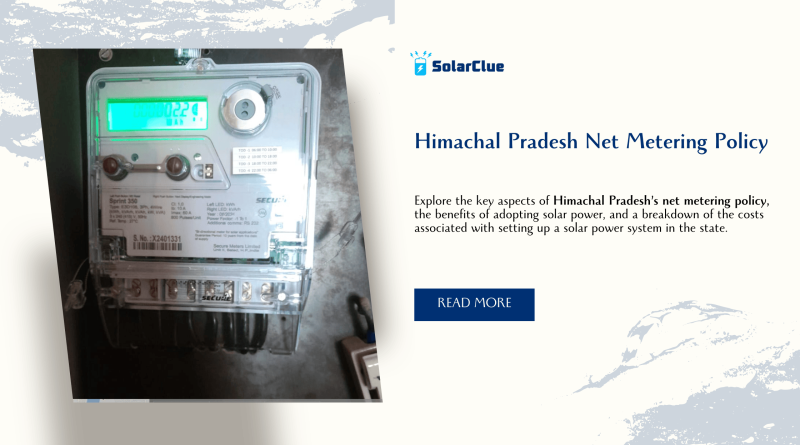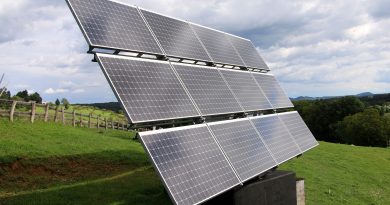Himachal Pradesh Net Metering Policy
Himachal Pradesh, known for its clean and green initiatives, has embraced solar energy as part of its commitment to a sustainable future. The state’s Net Metering Policy is designed to encourage the installation of solar rooftop systems in homes, businesses, and institutions. This policy allows consumers to generate their own electricity from solar power and feed excess energy back into the grid, earning credits that can significantly reduce electricity bills.
In this blog, we will explore the key aspects of Himachal Pradesh’s net metering policy, the benefits of adopting solar power, and a breakdown of the costs associated with setting up a solar power system in the state.
Table of Contents
What is Net Metering?
Net metering is a system that allows consumers who generate electricity using renewable energy sources, such as solar, to connect their system to the grid. If the consumer generates more energy than they use, the excess electricity is exported to the grid, and they receive credits for it. These credits can be used to offset future electricity bills.
The Himachal Pradesh Electricity Regulatory Commission (HPERC) regulates the net metering policy, ensuring that consumers can connect their solar systems to the grid with ease and benefit from the energy they produce.
Key Features of Himachal Pradesh Net Metering Policy
1. Eligibility Criteria
- Consumer Types: The policy is available to residential, commercial, industrial, and institutional consumers.
- System Size: Solar rooftop systems ranging from 1 kW to 2 MW are eligible under the policy.
- Connection Type: The policy applies to consumers connected to the grid through the state’s distribution companies, such as Himachal Pradesh State Electricity Board Limited (HPSEBL).
2. Solar System Capacity
- The capacity of the solar rooftop system must not exceed the sanctioned load or contract demand of the consumer’s connection.
- The maximum allowed solar system size for net metering is 2 MW, but for residential consumers, it typically does not exceed 500 kW.
3. Energy Billing and Settlement
- A bi-directional meter records both the electricity consumed from the grid and the electricity exported back to the grid.
- Consumers are billed based on the net energy consumed (imported energy minus exported energy).
- Settlement Period: Energy credits are settled on a monthly basis, and any excess energy credits can be carried forward to the next billing cycle. At the end of the financial year, any unutilized credits will lapse.
4. Installation and Maintenance
- Consumers bear the cost of installing solar rooftop systems.
- Maintenance of the solar system, including regular cleaning and inspection, is the consumer’s responsibility.
- The system must be installed by approved vendors to ensure it complies with HPSEBL standards.
5. Government Incentives and Subsidies
- The Ministry of New and Renewable Energy (MNRE) offers subsidies of up to 40% for systems up to 3 kW and 20% for systems between 3 kW and 10 kW.
- Himachal Pradesh offers additional incentives through state schemes to promote the adoption of solar energy.
Benefits of Net Metering in Himachal Pradesh
1. Reduction in Electricity Bills
Net metering allows consumers to generate their own electricity and reduce their reliance on the grid. By exporting excess energy to the grid, they earn credits that can offset future electricity bills, leading to substantial savings.
2. Environmentally Friendly
Himachal Pradesh is known for its natural beauty, and by encouraging the use of solar energy, the state reduces its dependence on non-renewable energy sources. Solar power helps decrease carbon emissions, contributing to cleaner air and water.
3. Energy Security and Independence
By generating their own power, consumers become more energy-independent. Solar energy can protect households and businesses from rising electricity tariffs and provide a reliable source of energy during grid outages.
4. Government Support
Consumers in Himachal Pradesh can take advantage of both central and state government subsidies, which make installing solar systems more affordable. These incentives can significantly reduce the initial investment required to set up solar rooftop systems.
5. Long-Term Financial Savings
Although installing a solar system may involve significant upfront costs, the payback period is typically between 5 to 7 years. After that, consumers benefit from free electricity for the remaining life of the system, which can last up to 25 years.
Key Highlights of Himachal Pradesh Net Metering Policy
| Aspect | Details |
|---|---|
| Eligible Consumers | Residential, Commercial, Industrial, Institutional |
| System Size | 1 kW to 2 MW |
| Maximum Solar Capacity | Up to 100% of sanctioned load (maximum 500 kW for residential consumers) |
| Billing Mechanism | Net metering with a bi-directional meter |
| Excess Energy Settlement | Monthly credit for surplus energy, carried forward to the next billing cycle |
| Meter Type | Bi-directional meter to track energy import and export |
| Subsidies | Up to 40% for systems up to 3 kW, 20% for systems between 3 kW and 10 kW |
| Connection | Must be connected to HPSEBL grid |
| Settlement Period | Monthly, with carryover of energy credits to the next billing cycle |
| Energy Credit Validity | Unutilized credits will lapse at the end of the financial year |
| Maintenance | Consumer is responsible for system maintenance |
| Government Incentives | MNRE and state-level subsidies available for solar installations |
| Environmental Benefits | Reduces carbon emissions, promotes clean energy |
How to Apply for Net Metering in Himachal Pradesh
1. Check Eligibility
Ensure your property qualifies for net metering under the Himachal Pradesh policy. The system size should align with your sanctioned load, and you must be connected to the HPSEBL grid.
2. Select an Approved Vendor
Choose an approved solar vendor who complies with the state’s technical standards. Ensure that the installer is certified and experienced in installing solar rooftop systems in Himachal Pradesh.
3. Submit Application for Net Metering
Submit an application to HPSEBL for grid connectivity. Application forms can be found online or at the nearest HPSEBL office. The utility will review your request and approve the installation.
4. Install a Bi-Directional Meter
A bi-directional meter is required to measure both the energy consumed from the grid and the energy exported to the grid. The meter must be installed and certified by HPSEBL.
5. Inspection and Approval
Once the solar system is installed, it will be inspected by HPSEBL to ensure it complies with all safety and technical standards. Upon approval, the system can be connected to the grid.
6. Start Generating Energy
After your system is connected, you can start generating solar power. Any excess energy you generate will be exported to the grid, earning you credits to reduce your electricity bills.
Estimated Cost of Installing a Solar System in Himachal Pradesh
The cost of installing a solar rooftop system in Himachal Pradesh varies based on the size of the system and the quality of the equipment. Below is an estimated cost breakdown for 1 kW, 3 kW, and 5 kW systems.
Estimated Cost for Solar System Installation in Himachal Pradesh
| Component | 1 kW System | 3 kW System | 5 kW System |
|---|---|---|---|
| Solar Panels | ₹25,000 – ₹40,000 | ₹75,000 – ₹1,20,000 | ₹1,25,000 – ₹2,00,000 |
| Inverter | ₹6,000 – ₹12,000 | ₹18,000 – ₹36,000 | ₹30,000 – ₹60,000 |
| Bi-Directional Meter | ₹5,000 – ₹10,000 | ₹5,000 – ₹10,000 | ₹5,000 – ₹10,000 |
| Mounting Structure | ₹1,500 – ₹3,000 | ₹4,500 – ₹9,000 | ₹7,500 – ₹15,000 |
| Wiring and Cabling | ₹2,000 – ₹4,000 | ₹6,000 – ₹12,000 | ₹10,000 – ₹20,000 |
| Installation and Labor | ₹5,000 – ₹8,000 | ₹10,000 – ₹15,000 | ₹15,000 – ₹25,000 |
| Total Estimated Cost | ₹44,500 – ₹77,000 | ₹1,18,500 – ₹2,02,000 | ₹1,92,500 – ₹3,30,000 |
Conclusion
Himachal Pradesh’s net metering policy provides an excellent opportunity for consumers to generate their own renewable energy, reduce electricity bills, and contribute to a cleaner environment. With government incentives and the long-term financial benefits of solar energy, adopting a solar rooftop system is a cost-effective and eco-friendly decision for households and businesses alike.
Ready to Save on Electricity Bills with Solar Power?
With Net Metering, you can drastically reduce your electricity costs by generating your own solar power and sending any excess back to the grid. It’s time to harness the sun’s energy and make a positive impact on both your wallet and the environment!
At SolarClue, we make the transition to solar simple, efficient, and affordable. Whether you’re a homeowner, business, or institution, our team of solar experts will guide you through the process—from installation to maintenance—so you can start saving from day one.
🌞 Take the first step towards energy independence today!
🔋 Get your solar consultation now!
Contact SolarClue or call us at +91-888-4444-830 to explore the best solar solutions for your home or business.
Go Solar. Save More. Power Your Future with SolarClue!
FAQs
1. What is the maximum capacity for a solar rooftop system in Himachal Pradesh?
The maximum capacity is 2 MW, but for residential consumers, it typically does not exceed 500 kW.
2. How does net metering reduce electricity bills in Himachal Pradesh?
Net metering allows you to export excess electricity generated by your solar system to the grid, earning credits that can be used to offset future electricity bills.
3. What subsidies are available for solar installations in Himachal Pradesh?
MNRE offers up to 40% subsidy for systems up to 3 kW and 20% for systems between 3 kW and 10 kW. Additional state incentives may also be available.
4. What is the payback period for a solar system in Himachal Pradesh?
The payback period typically ranges from 5 to 7 years, depending on system size and electricity usage.
5. Is net metering available for businesses in Himachal Pradesh?
Yes, net metering is available for commercial and industrial consumers, along with residential and institutional users.




